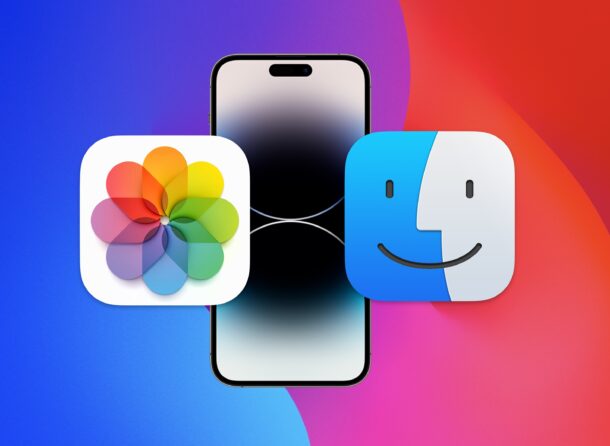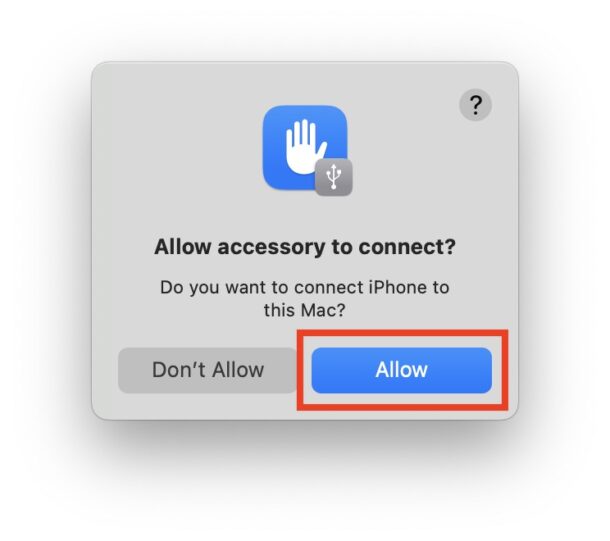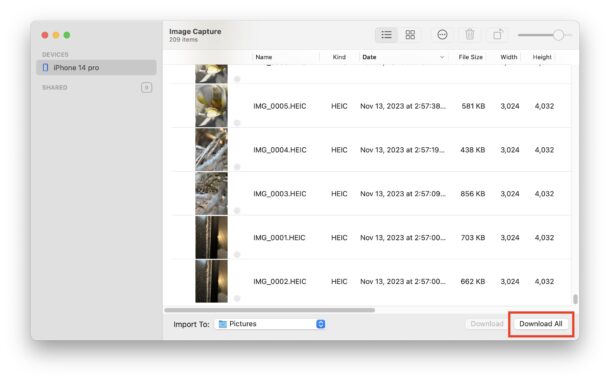How to Transfer Photos from iPhone to Mac Without iCloud

If you’re accustomed to using iCloud to keep your photos synced between your iPhone, Mac, or even Windows PC, you may not be familiar with the process of transferring pictures off of the iPhone without using iCloud.
This tutorial will walk through the steps required to get pictures from your iPhone to your computer, without using iCloud.
How to Transfer Pictures from iPhone Without iCloud to Mac
This process will copy the photos from iPhone to the Mac, without using iCloud, and instead rely on the bundled Image Capture application to complete the transfer:
- Connect the iPhone to the Mac with a USB cable
- Choose “Allow” when requested to have access to the USB device, this is your iPhone
- Open the “Image Capture” application, from the /Applications folder, or by hitting Command+Spacebar to bring up Spotlight and typing “Image Capture” and hitting return
- Select your iPhone from the left side menu in Image Capture
- Optionally, choose a specific destination on the Mac by clicking on the ‘Import to’ dropdown menu, or accept the Pictures folder default
- To transfer all the photos from iPhone, click the “Download All” button in the bottom right corner
- To copy select photos from iPhone to Mac, select each picture and choose “Download” in the bottom right corner
- Let the photo transfer complete, the pictures will be in the destination folder (default as user Pictures/ directory) when finished


USB file transfer for photos is relatively fast, but depending on the number of photos and/or length of videos you’re copying, it may take a few minutes or longer.
Using Image Capture is one of the simplest and most direct ways to copy photos from an iPhone without using iCloud, but you can also use the Photos app (without or with iCloud Photos enabled on the Mac, the app can still manage photos), Preview app, and multiple third party apps too.
If you regularly copy photos from your iPhone to your Mac without using iCloud, which method do you use? Do you have any helpful tips or information you want to share? Just leave a comment and join the conversation.


I use Air Drop. Easy and fast. I do it regularly so I just need to do a few at a time.
In my now non-paying job, I regularly transfer photos from my iPhone to my Macbook. Above, you have outlined a useful method, but I always use AirDrop. It works so much easier, is fast, and like me, avoids the Cloud. I chose to avoid the Cloud from its inception on the basis that I would never go near anything which places my files anywhere beyond my hard drive.
I used image capture to get photos off my iPhone for years. Then I started using iCloud with two devastating consequences that I do not know how to get out of: firstly, to save space on my iPhone iCloud turned my photos there into a much smaller file-size. To download these mini-copies via image capture no longer makes sense. However, when I download the full-size photos via iCloud, all the metadata is missing, which is truly devastating!!! I would like to retain at least date and time of capture, location, etc. Apparently this is not possible via iCloud download. I now would like to reverse the small sizes on the phone, but do not even find a way to delete enough older pictures manually, to make the room. Has anyone encountered this, and found a solution?
I used image capture to get photos off my iPhone for years. Then I started using iCloud with two devastating consequences that I do not know how to get out of: firstly, to save space on my iPhone iCloud turned my photos there into a much smaller file-size. To download these mini-copies via image capture no longer makes sense. However, when I download the full-size photos via iCloud, all the metadata is missing, which is truly devastating!!! I would like to retain at least date and time of capture, location, etc. Apparently this is not possible via iCloud download. I now would like to reverse the small sizes on the phone, but do not even find a way to delete enough older pictures manually, to make the room. Has anyone encountered this, and found a solution?
If you use Photos, it keeps track of pics that have been downloaded, and won’t download them again unless you specify them. When I plug in my phone, or memory card from my camera, I get the option: Import new photos? and that’s what I usually end up doing. It imports Live Photos seamlessly and has no problem with RAW formats.
As for AirDrop, I’ve never had to do anything with iCloud or my Apple ID. You simply pick an acceptable target and it gets sent. If it’s not one of your devices, they will have to accept the transfer, but if it’s one you’re logged into (say your Mac) it goes into Downloads immediately.
OK, now that I have the THOUSANDS of photos on my big-screen-desktop (where I can see them better)….how do I go about deleting all the duplicates or others I do NOT want to keep? Trying to pick the best group shot of everyone from a 3″ screen is difficult. So now I can ‘keep the best and dump the rest’…..BUT….how can I also make sure they are GONE off iCloud, my iPhone, AND my desktop…?? I don’t want to spend hours dumping them – only to see them still on my other devices…. THX!
I’d sure like to know how to transfer photos from my iPhone to my PC without iCloud.
We’ll be sure to cover iPhone to PC without iCloud as well. It’s arguably a bit easier on Windows, because the iPhone gets detected as a digital camera when connected with USB, letting you access the photos directly in Windows Explorer as if it were a digital camera.
There are two methods for Windows covered here, too:
https://osxdaily.com/2017/01/13/how-transfer-photos-iphone-windows-10-pc/
Hello, thanks for the info. I use Photos to download photos from my iPhone onto my Mac. OSX makes it easy to access my pics in Photos while in any other application.
I don’t like syncing Photos on my devices with iCloud as it fills very quickly and then you’re in need of buying (renting) more space from Apple.
Me again, I tried your method and I hate it when instructions like this are wrong and/or incomplete. In this case, you left out the bit about unlocking your phone, and Step #5 is incomplete.
“5. Optionally, choose a specific destination on the Mac by clicking on the”
… the what?
Finally, this method gave me a bunch of files ending in .AAE. What are those and where did they come from?
iPhone SE 2, iOS 17.1, MBAir (M1) Ventura 13.6.1
Thanks for noticing the typo, not sure how that made it through but it has been corrected.
Whether or not you need to unlock your iPhone depends on a variety of user conditions, but obviously if you have a locked device you need to unlock it before you use it.
Great question about the AAE files! AAE files store data about an edited photo, and are what allow edits to be made in the Photos app (on MacOS/iOS/iPadOS) and still be reverted to their original. They correspond to photos that have edits made to them. Perhaps we’ll touch on that separately, since many users will likely run into AAE files over time, and they are not self-explanatory.
I use Air Drop. Simple, fast, accurate
I use Air Drop. Everything winds up in the “Downloads” folder.
AirDrop is incredibly convenient and I use it frequently too!
However, AirDrop requires iCloud / Apple ID. A surprising number of Apple users do not use iCloud or have forgotten their passwords to their Apple ID, rendering some of those features inaccessible to them.
An alternative (though not free) way that is wireless and very easy is the PhotoSync App, which is what I’ve been using for a year or two now. I’ve no connection with the application except as a happy customer.